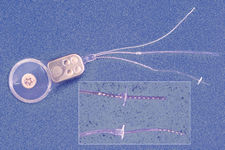
Dr
Bruce Gantz's Iowa/Nucleus Hybrid Cochlear Implant
|
Treating severe hearing loss
has always forced doctors to make tough decisions. Cochlear
implants have long been used as a last resort when hearing
aids no longer cut it. Trouble is they tend to accentuate
high pitch sounds and destroy any residual low frequency
hearing. Ten years ago Dr Bruce Gantz, who heads the otolaryngology
department at the University of Iowa, decided the status
quo just wasn't good enough for his patients and set out
to come up with an alternative.
The result, his experimental hybrid
cochlear implant, melds bionic technology with traditional
hearing aids. But the key to his device is that it's
far less invasive than traditional cochlear implants
and appears to preserve low frequency hearing. "I started
with the concept of trying to stimulate only the areas
of the inner ear that seem to be major sources of hearing
loss — the high frequency areas. This fits most
people who have hearing loss due to aging, genetic causes
or noise exposure," he explains. The 2000Hz and higher
region is where consonants are interpreted. "When you
start losing significant hearing, speech becomes muddled
because you don't understand all the consonants that
are there," he says.
So far, 65 patients have been fitted
with Dr Gantz's hybrid cochlear device. And trials are
going well. "We've been able to save most of the low
frequency hearing in all those patients," he said. "People
who have an average of 25% word understanding with hearing
aids are up to over 70% word understanding with the
hearing aid plus the implant."
COCHLEAR
CONUNDRUM
Though originally only used in very extreme cases, more
recently cochlear implants have seen their indication
expand to folks with a modicum of hearing left. This
didn't sit too well with Dr Gantz. "There's a potential
downside of putting a traditional cochlear implant in
a patient who has some residual hearing because you'll
most likely destroy it."
Dr Gantz figured that smaller is
better. "We used a small electrode — only 0.2mm
by 0.4mm — whereas standard electrodes are about
1.2mm in diameter," he explains. When you start advancing
a traditional electrode into the cochlea, which is coiled
like a snail, it tends to ride against the outer wall,
pushing the device up towards the hair cells —
acoustic sensors that convert vibration into an electrical
signal in the inner ear. So by placing larger electrodes
in the cochlea there's a good chance you'll end up damaging
the inner ear. "Our thought was to try and limit the
amount of damage to only that area in the inner ear
where high frequency is," says Dr Gantz.
IN
ONE EAR
The Iowa/Nucleus Hybrid Cochlear Implant System —
as it's officially called — won't be widely available
for a while yet. "We're probably going to go to the
FDA mid-year or so and let them evaluate our results,"
says Dr Gantz. "Even then it will only be able to be
fitted by very specialized ear doctors because there's
still a risk to the inner ear and it will require some
training," he adds.
If they do come on the market,
what kind of patients would be right for the hybrid
device? "It'd be people who have a lot of trouble understanding,
who aren't able to use hearing aids very well to improve
their word understanding, and people with trouble hearing
in noise," says Dr Gantz.
And the device holds promise for
music-lovers too. "We're doing a lot of testing involving
music," says Dr Gantz. "Melody recognition in subjects
with the device is almost on par with those with normal
hearing because those low frequencies are preserved,
so it's a very important step. Most patients with [traditional]
cochlear implants don't do very well with music," he
adds.
|